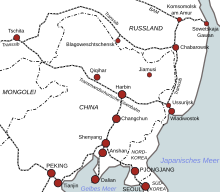East China Railroad
The Chinese Eastern Railway ( Russian Китайско-Восточная железная дорога, КВЖД ) (since August 1945 - Chinese Changchun -Eisenbahn , Russian Чанчуньская железная дорога , since 1953 - Harbin Railway ), also known as Manchurian Railway known is a railway highway in northeast China. It connects Chita with Vladivostok and Dalian-Lüshunkou (formerly Port Arthur ) and leads through the historical Chinese landscapes of Inner Mongolia and Manchuria .
history
The East China Railway was built from 1897 to 1903 as part of the Trans-Siberian Railway between Chita and Vladivostok. At that time, Manchuria was part of the Russian Empire's sphere of influence as part of the open door policy in China supported by the great western powers . A rapid succession of various difficulties caused the construction costs to skyrocket: in 1899 and 1901, bubonic plague broke out and in 1902 cholera broke out among the builders. In 1900 the Chinese workers joined the Boxer Rebellion and destroyed around 700 kilometers of track. After the Russian defeat in the Russo-Japanese War , Russia lost its influence in northern China for a long time from 1905 and built a new section of the Trans-Siberian Railway between Chita and Vladivostok, which lay entirely on Russian territory. The Chinese Eastern Railway lost its importance considerably.
The first president of the East China Railway Company was the diplomat Xu Jingcheng , who, however, was sentenced to death for his role in the Boxer Rebellion before the line was commissioned and executed in July 1900. Another president among others was Li Shaogeng . In October 1920, a serious rail accident occurred near Pogranitschny when a mail train derailed on its way from Vladivostok to Harbin. One hundred people are said to have died.

After the October Revolution , the government of Soviet Russia published the so-called Karachan Manifesto on July 25, 1919 , in which it condemned the "imperialist goals" of the Russian Empire in China and waived all special political rights and claims of the former Russian government against China. The handover of the East China Railroad was also explicitly listed in this document. In the course of the Stalinist expansionist efforts in northern China, Stalin had to have the existence of this announcement confirmed a short time later, but the Soviet government now emphasized to the Chinese government that the manifest did not mention a free handover of the railway line.
In this episode, the Soviet Union occupied until 1929 some 67 percent of all stations of the Chinese Eastern Railway, then on 17 August 1929, the Soviet-Chinese border war (Russian Конфликт на Китайско-Восточной железной дороге;. Conflict Chinese Eastern Railway ) between the Soviet Red Army and the Army of the Republic of China broke out. This conflict lasted around five months and spread across Manchuria. 2000 Chinese and 187 Russian soldiers lost their lives. On December 22, 1929, the Chinese signed a peace treaty in Khabarovsk . De jure , the status quo ante of 1924 was agreed, thus confirming the existing border treaty between China and the Soviet Union. De facto, the Soviet Union gained influence in China, culminating in 1931 with the establishment of the Chinese Soviet Republic (1931–1934; Shaanxi region ).
After the occupation of North China by the Kwantung Army , the USSR sold the East China Railroad to Japan's puppet state Manchukuo , which bordered the Mongolian People's Republic , the satellite state of the Soviet Union, in 1935 . The government of Manchukuo had the line originally laid out in Russian broad gauge of 1,524 mm re- gauged to the standard gauge of 1,435 mm used in China within a very short time .
In the course of Operation August Storm , the Soviet Union again made claims and took possession of the East China Railroad despite Chinese protests. With the signing of the Sino-Soviet Friendship Treaty , the USSR renounced its special rights in northern China and finally handed over the East China Railway to China on February 14, 1950, whereby it did not vacate Lüshunkou (formerly Port Arthur) until 1955 and until then used the route for troop transports.
See also
literature
- Sören Urbansky : Colonial Competition. Russia, China, Japan and the East China Railway. campus , Frankfurt am Main 2008, ISBN 9783593387710
- Vladimir Kotelnikow: The "Chinese Railway War" of 1929 . Flieger Revue Extra No. 24, Möller, Berlin 2009.
Web links
Individual evidence
- ^ Peter WB Semmens: Catastrophes on rails. A worldwide documentation. Transpress, Stuttgart 1996, ISBN 3-344-71030-3 , p. 60.
- ↑ Bruce A. Elleman: The Soviet Union's Secret Diplomacy Concerning the Chinese Eastern Railway, 1924-1925. Journal of Asian Studies, Volume 53, pp. 461-471.
- ↑ Michael Walker: The 1929 Sino-Soviet War. University Press of Kansas, 2017, p. 81.
- ↑ GF Krivosheev: Soviet Casualties and Combat Losses in the Twentieth Century . Greenhill Books, 1997, p. 370, table 111.
- ↑ International law, reports and documents: Die Ostchinesische Bahn (p. 379) Max Planck Institute for Comparative Public Law and International Law, accessed on September 8, 2017
- ↑ Felix Patrikeeff: Russian Politics in Exile: The North East Asian balance of power, from 1924 to 1931. In: Manchurian Railways and the Opening of China: An International History, Basingstoke 2002, p. 16.
- ^ Sergej Slutsch, Carola Tischler: Germany and the Soviet Union. Volume 1. 1933/1934. Walter de Gruyter, 2014, p. 186
- ↑ Transmanchourien-express on trains-worldexpresses.com (accessed on July 30, 2013)
- ↑ Michael Strupp: China's territorial claims. Institute for Asian Studies, 1982, p. 95.
